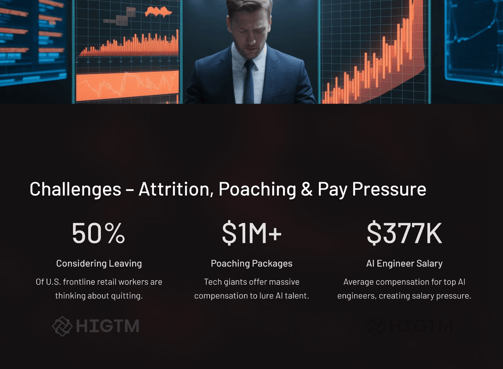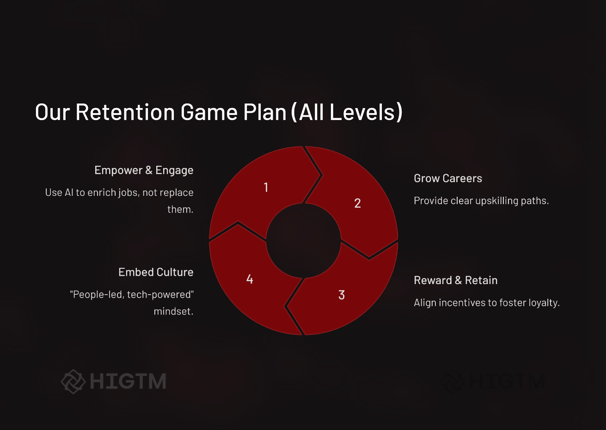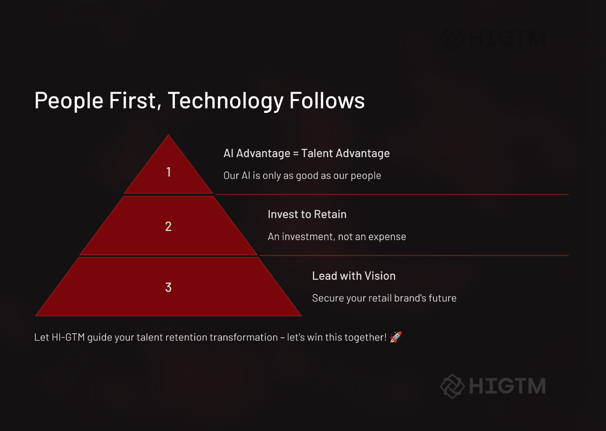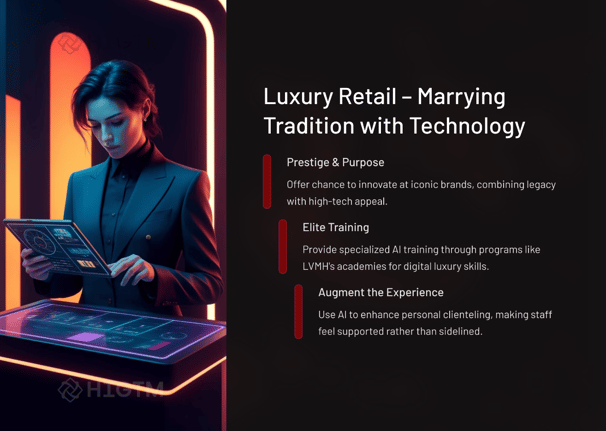66. How Retail Can Keep AI-Savvy Staff: 4 Sector-Specific Talent Retention Strategies
Retailers are facing a new kind of talent war. Your best AI-savvy employees – whether coding in corporate or innovating on the shop floor – are being courted by tech giants and edgy startups. High turnover rates in retail (averaging about 60% annually in the U.S.) make this even more urgent. The challenge is clear: how do we retain our AI-skilled staff at all levels, across diverse retail subsectors? Below, we explore strategies tailored to fashion, grocery, e-commerce, and luxury retail. Each sector has its own twist on retention, but all share a common theme – investing in people to secure the future.
Q1: FOUNDATIONS OF AI IN SME MANAGEMENT - CHAPTER 3 (DAYS 60–90): LAYING OPERATIONAL FOUNDATIONS
Gary Stoyanov PhD
3/7/202513 min read

1. Fashion Retail: Retaining Talent in Trend-Driven Retail
1.1 Cultivate Creative Tech Teams (Corporate Level)
Fashion retail thrives on creativity and speed. To keep corporate AI talent (data scientists, AI developers, digital merchandisers) engaged, infuse their work with the same creative energy that drives design and branding. For example, involve AI teams in trend-forecasting and product development alongside designers. Companies like Stitch Fix famously let algorithms and human stylists co-create, which has attracted top data talent. Encourage your tech staff to experiment with AI for design inspiration or inventory optimization that feels like a creative challenge, not just number crunching. Also, articulate a clear career path that blends tech and fashion. An analyst might progress to “AI Fashion Strategist,” bridging data insights with creative decision-making. Walmart’s HR chief notes that focusing on skills and offering broad career pathways makes employees less likely to leave for a “better experience” elsewhere.
In fashion, that means showing how a tech role can evolve within the company’s various brands, or even into general management. When AI professionals see they can grow and stay connected to the glitz of fashion, the allure of Silicon Valley dims by comparison.
1.2 Empower Store Managers with AI Tools (Store Management)
Store and regional managers in apparel retail are under pressure to hit sales targets and respond to fast-changing trends. Retain these key players by turning AI into their personal assistant. Provide user-friendly analytics dashboards that forecast hot items, identify local buying patterns, and even suggest staffing plans for peak hours. By taking guesswork out of decisions, AI tools reduce stress and help managers feel more effective.
For example, if an AI system alerts a store manager that a certain style of jeans is trending on social media in their city, they can proactively rearrange displays or request more stock. This makes their job more exciting (almost like a strategy game) and less reactive firefighting. Also invest in leadership development specifically around technology – e.g., training programs where managers learn how to leverage data in decision-making. A well-trained, tech-savvy store manager is more confident and likely to stay on rather than feel overwhelmed and burnt out. When fashion retailers show their managers that embracing AI will make them better leaders (and not obsolete), it builds loyalty.
1.3 Elevate Frontline Roles with High-Tech Flair (Frontline Staff)
Frontline fashion retail jobs (sales associates, visual merchandisers) often see high turnover, but strategic use of tech can change that. Today’s younger retail workers are digitally native – give them modern tools that make the job fun and engaging.
For instance, implement mobile clienteling apps that use AI to recommend outfits for customers based on browsing history or past purchases. Training associates to use such apps turns them into style advisors armed with data, a role far more fulfilling than “just folding clothes.” Some fashion stores have introduced smart fitting rooms with touchscreens and AR mirrors that suggest accessories; associates then become curators of a high-tech customer experience.
This kind of environment can attract and retain talent who love tech as much as fashion. Moreover, involve frontline staff in social media and e-commerce integration – e.g., let them contribute content or feedback to the online team, blurring the line between in-store and digital. An associate who might one day move into a digital marketing or e-commerce role will be motivated to stick around if they see those internal mobility options. Remember, part-time retail employees suffer ~76% turnover, but giving them skills and variety can significantly improve loyalty. Even something as simple as more predictable schedules through AI scheduling systems (to ensure they have work-life balance) shows you value their time – and valued employees tend to stay.
2. Grocery Retail: Keeping Talent in High-Volume, Low-Margin Environments
2.1 Emphasize Purpose and Impact (Corporate Level)
Grocery retail might not seem as “sexy” as fashion or tech to an AI engineer, so retaining corporate talent here hinges on highlighting the purpose behind the work. Make sure your data scientists and IT folks understand the real-world impact of their projects. For example, an algorithm that optimizes supply chain routes isn’t just saving money – it’s ensuring fresh produce reaches communities on time and reducing food waste. Frame their achievements in human terms: “Because of your code, thousands of families got fresher food and the store donated less to the dumpster.” Many employees today, especially Millennials and Gen Z, crave meaning. Grocery chains like Kroger often stress how their analytics improve the customer’s daily life, giving tech talent a mission to rally around. Also, due to tighter margins, grocers can’t always pay top dollar for AI roles, so purpose can be a powerful counterweight to salary offers from elsewhere. In addition, create a community atmosphere at corporate – host volunteer events or nutrition hackathons – where AI staff collaborate with dietitians or sustainability teams. If your corporate AI team feels they’re part of something socially worthwhile and uniquely grocery (like improving public health), they’re less likely to jump to a tech company where the mission is less tangible.
2.2 Grow Your Own Tech Experts (Store Management to HQ)
One advantage grocery retailers have is a large workforce with deep operational knowledge. Tapping into this pool for AI talent is a win-win: you retain ambitious employees by offering them advancement, and you get new tech talent that understands the business from the ground up. Consider creating a formal upskilling pipeline where promising store managers or analysts get trained in data science or AI through partnerships with universities or online programs. Walmart’s Live Better U program, which covers 100% of tuition for employees’ degrees, is a model aiming to boost retention by fostering internal mobility.
A grocery context example: a department manager who learns Python and analytics could transition to a regional data analyst role, helping all stores optimize their ordering. This not only motivates that individual to stay (they got a career boost without leaving), but also signals to all employees that “career paths at this company are limitless.” Nestlé’s internal talent marketplace, connecting employees to new projects company-wide, shows how mobility prevents siloed career stagnation.
Grocers can implement similar internal job platforms so an employee in a store can find a HQ tech opening and vice versa. By developing talent from within, you also sidestep some of the salary arms race for external hires – you’re essentially converting loyal operational staff into tech staff, with a likely higher loyalty quotient.
2.3 Make Frontline Jobs Smarter and Safer (Frontline Staff)
Retention on the grocery frontline (cashiers, shelf stockers, etc.) is notoriously tough, so improvements here can have huge payoffs given the scale. One effective strategy is using AI to remove the most frustrating aspects of these jobs, making the day-to-day more pleasant. Scheduling is a prime example: erratic schedules drive people away, so use an AI-driven workforce management system that creates stable schedules and considers employee preferences. Advanced scheduling AI can match staffing to store traffic while honoring more time-off requests, which leads to happier staff who feel respected. Additionally, introduce automation carefully to assist, not replace, workers.
For instance, an AI-powered inventory scanner (a small robot or even drone) that roams aisles at night finds out-of-stock items or pricing errors. Instead of eliminating the need for human stockers, it makes their job more efficient – they come in each morning with a “to-do list” of exactly what needs restocking. This eliminates tedious manual checks and lets them focus on tasks with a bit more satisfaction (like setting up attractive displays or helping customers). When employees feel their time is used wisely and not wasted on drudgery, they’re more likely to stay.
Safety and comfort matter too: AI can help predict busy periods or even aggressive customer incidents, allowing management to staff appropriately and support employees (e.g., having extra baggers during a rush to avoid stress). In short, use AI to turn a once tough, thankless job into a more predictable, supported role where employees feel their well-being is a priority. Lower stress and higher respect translate into better retention.
3. E-Commerce: Retaining Tech Talent in a Tech-Intensive Retail Environment
3.1 Create a Tech Startup Culture Inside (Corporate Level)
E-commerce players (or the e-commerce divisions of omnichannel retailers) are competing directly with Google, Meta, and startups for engineering and AI talent. To retain these highly mobile professionals, cultivate a startup-like culture internally. This means flattening hierarchies where possible, promoting creative freedom, and embracing modern workflows. Encourage an environment of continuous learning: host internal hackathons, allow 10-20% time for passion projects related to the business, and bring in guest speakers from the AI industry. Big retailers like Home Depot and Walmart have opened tech hubs in Silicon Valley and Austin to access talent and infuse that culture; even if you’re not in a tech hotbed, you can simulate it with remote work options and digital collaboration. Another aspect is tooling – e-commerce techies want to work with the latest and greatest. Ensure your infrastructure (cloud services, ML platforms) is up-to-date; this signals to talent that they won’t stagnate using outdated tech on your watch. BCG notes that companies must offer a compelling value proposition and modern environment to hold onto prized AI recruits.
In practice, this could also mean fostering an internal open-source mindset (contributing to open-source projects, publishing engineering blogs) which gives employees a sense of community and pride. When your e-commerce team feels like they’re part of a cutting-edge outfit, not a staid corporate IT department, they’ll be less susceptible to the lure of actual startups.
3.2 Reward with Growth and Ownership (Corporate Level)
Compensation in e-commerce roles needs to be competitive, but retention isn’t only about salary. Offer long-term incentives that make sticking around attractive. Equity is a big one – if your company can grant stock or stock options, do it. Many traditional retailers have begun to include equity for corporate tech hires, closing the gap with startups where equity is expected. If stock isn’t feasible at lower levels, consider profit-sharing bonuses tied to e-commerce growth metrics, so employees feel directly connected to the company’s success. Also, outline a growth trajectory: e-commerce and AI teams should see a path to senior leadership. Perhaps the Chief Digital Officer today could become the CEO tomorrow – make sure that internal promotions to the highest ranks happen, to prove to ambitious talent that they don’t have to leave to fulfill their career dreams. Walmart’s senior leadership emphasized giving big responsibilities early and enabling “several careers within a career” as a key to retention.
In e-commerce, that might mean rotating high-potential employees through different roles – from data science to product management to operations – to broaden their skill set. Mentorship programs connecting junior AI engineers with seasoned executives can also inspire loyalty; those relationships become hard to part with. Finally, recognition is huge: celebrate successes of your tech teams publicly within the company. Whether it’s an award, a shout-out in the CEO’s email, or even patent bonuses for innovative solutions, recognizing their contributions builds emotional loyalty that salary alone cannot buy.
3.3 Maintain Work-Life Harmony and Flexibility (All Levels)
E-commerce never sleeps, and burnout is real. One often overlooked retention strategy is to guard against the “crunch time” culture. Use AI to help here too: for instance, predictive analytics might forecast holiday surges, allowing better resource planning so your teams aren’t firefighting last-minute.
Plan code freezes and reasonable on-call rotations so people can actually take vacations without a laptop in tow. Offer flexibility that tech workers expect: remote work options, flexible hours, or a results-only work environment. If an AI developer wants to work from home three days a week or relocate to a cheaper city, and their work can be done remotely, accommodate it – otherwise you risk them finding an employer who will. Many e-commerce operations have successfully embraced hybrid teams spread across cities after 2020; advertise that as a perk.
On the customer service frontline of e-commerce (like live chat agents or support analysts who are also using AI tools), apply similar flexibility and use AI assistance to reduce their stress (AI can handle routine queries, leaving humans with more interesting problems and manageable workloads). When your employees see that the company cares about their quality of life, not just the bottom line, it fosters loyalty. After all, a competitor might offer $20k more, but if it comes with 80-hour weeks and high stress, a balanced job will win out for many. Protect your teams from burnout and they’ll be far more likely to stick with you for the long haul.






4. Luxury Retail: Retaining Talent Where Heritage Meets Innovation
4.1 Offer Prestige with Innovation (Corporate Level)
Luxury retail brands have a unique edge in retention: the power of their brand heritage and exclusivity. Use that! Remind your AI and digital talent that by working for your luxury house, they are part of a storied legacy that few tech jobs can match. At the same time, give them opportunities to push the envelope in innovation. Luxury customers expect high personalization and excellent service, which opens exciting projects for AI folks – from developing ultra-personalized recommendation engines for VIP clients to implementing AI for quality control of craftsmanship. LVMH’s partnership with Google Cloud on AI solutions for personalization and inventory is a real example – but the key internally is to show your talent that they are central to these marquee innovations.
Consider special cross-brand projects if you’re a luxury conglomerate (like a rotation where an employee works on AI at Louis Vuitton, then at Dior – a very unique career journey!). This not only deepens their skills but also amps up the prestige factor. Another idea: send your top tech talent to represent the brand at global tech or luxury conferences. Let a data scientist attend a fashion week event or a luxury symposium, bridging the gap between tech and luxury lifestyle. They’ll feel proud to be an ambassador of the brand’s innovation. The combination of prestige + cutting-edge work can be more satisfying than a generic job at a tech firm for many people – leverage that in your retention storytelling.
4.2 Invest in Elite Training and Mentorship (All Levels)
Luxury brands are known for investing in craft; extend that philosophy to investing in your people’s skills. Create an “AI Academy” for luxury retail that trains employees on how to use data and AI while preserving the brand’s essence. This could include workshops on leveraging client data ethically to enhance service, or training store associates in using CRM systems powered by AI. By making training feel exclusive (“only the best get this level of development”), you instill a sense of pride and loyalty. For corporate tech talent, mentorship from high-level executives can be a golden handcuff. Imagine being a young machine learning expert and getting mentorship from the Chief Marketing Officer or even a session with a creative director to understand the artistry of the products.
These experiences are unique to luxury retail and can be deeply engaging. Also, encourage mentorship in the other direction: tech-savvy staff mentoring long-time employees on digital skills. This fosters mutual respect and bonds within the company. A senior boutique manager who learns data analytics from a younger colleague, and that younger colleague who learns refined customer service techniques in return, are both more likely to stay because they’ve grown and feel valued. Essentially, make your organization a guild for talent – where continuous learning is the norm, and it’s done in a very luxury way (think high-end e-learning platforms, certificates handed out at elegant ceremonies, etc.). This sense of belonging to an elite club can be a strong retention factor.
4.3 Blend Tech with the Human Touch in Stores (Store Management & Frontline)
In luxury retail stores, the sales advisors and store managers are akin to performers on a stage – they deliver an experience, not just a product. As AI and digital creep in, some may fear it will dilute the personal touch. Counter that by using AI to augment their artistry, not replace it. Equip store staff with rich data about client preferences via AI-driven CRM tablets, so they can offer truly personalized recommendations. For instance, when a regular client walks in, a boutique associate could get a gentle prompt that “Last time, Ms. Lopez bought a size 38 black pump; new seasonal arrivals in her size and style preference are in stock.” Now the associate can delight the client without the client even asking – a high-tech assist to a high-touch service. Make sure to communicate to staff that the AI is their tool, part of their repertoire for delivering excellence. This increases their confidence rather than making them feel obsolete. Some luxury brands also use AI for behind-the-scenes tasks like managing inventory for made-to-order items – this frees the staff to focus on customers rather than paperwork, again enhancing job satisfaction.
Importantly, involve frontline staff in the rollout of any new tech: ask their input, let a couple of star associates test a new clienteling app and become trainers for their peers. When people feel included in the innovation process, they champion it rather than resist it. The result is a workforce that sees technology as part of the luxury experience they curate, not a threat. They’ll want to stay because they’re empowered to give customers something no one else can, with the help of tools that no one else has. In luxury, that sense of pride in craftsmanship – now digital craftsmanship – can significantly boost retention of both seasoned professionals and tech newcomers.


5. Conclusion: Winning the Retail AI Talent Marathon
At the end of the day, retaining AI-savvy staff in retail comes down to a simple principle: invest in your people as deeply as you invest in technology. Retail has always been a people business, and that hasn’t changed in the age of AI – if anything, it’s more important than ever. The best algorithms in the world won’t deliver value if you don’t have a loyal, skilled team to implement, interpret, and improve them.
From fashion to grocery to e-commerce to luxury, we’ve seen that each retail subsector can adopt tailored tactics to keep their talent. Whether it’s giving a fashion data scientist a creative outlet, a grocery store manager a new career in analytics, an e-commerce engineer a sense of ownership, or a luxury sales associate a high-tech edge, the strategies share a common thread: make your people feel valued, challenged, and part of a grand mission.
Benchmarking the leaders tells us this works. Companies that are leaders in retention regularly enjoy lower turnover and higher sales growth – McKinsey found that frontline employees at top-quartile retail employers leave half as often as those at the rest, and their stores outperform in sales.
It’s no coincidence – stability breeds performance. And stability is earned by caring for your team. It means pre-empting burnout, offering growth, and building a culture that a competitor’s recruiter can’t easily peel someone away from.
In a world of attrition and poaching, the retailers who succeed will be those who turn themselves into magnets for talent. That means competitive rewards, yes, but also intangibles like pride, purpose, and culture. As the examples of Walmart, Amazon, Nestlé and others show, innovative retention investments – from education programs to AI assistants for employees – pay off in loyalty and results. Even if you can’t match the tech titans dollar for dollar in salary, you can offer something powerful: a place to build a fulfilling career and to be part of a winning team rewriting the rules of retail.
The race for AI talent in retail is not a sprint, it’s a marathon. By implementing the sector-specific strategies outlined above and continually listening and adapting to your employees’ needs, you’ll build endurance. You’ll keep the brilliant store manager who can execute a data-driven strategy, the genius programmer who can personalize your customer experience, and the forward-thinking associate who turns shopping into an adventure.
Keep them, grow them, and your company will thrive. In the era of smart stores and digital commerce, your people are the ultimate competitive advantage – take care of them, and they’ll take care of your business.
Turn AI into ROI — Win Faster with HIGTM.
Consult with us to discuss how to manage and grow your business operations with AI.
© 2025 HIGTM. All rights reserved.
